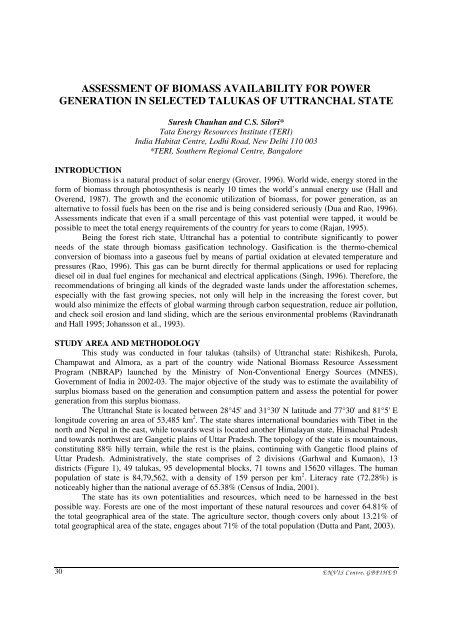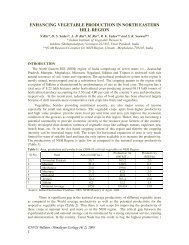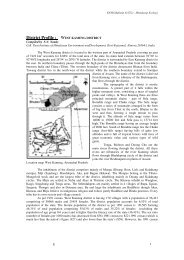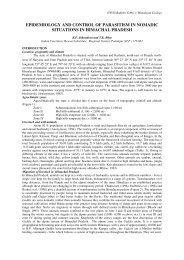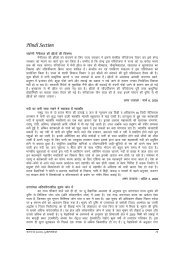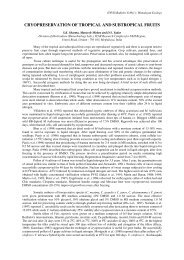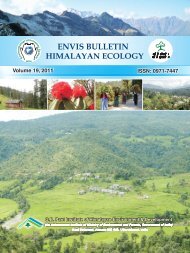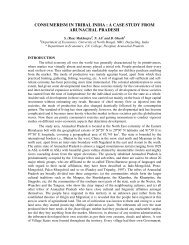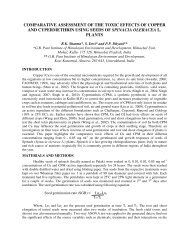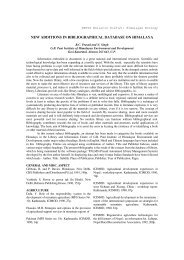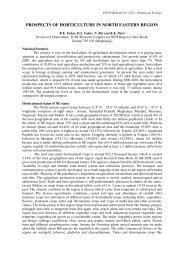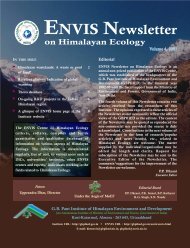ENVIS BULLETIN - ENVIS Centre on Himalayan Ecology
ENVIS BULLETIN - ENVIS Centre on Himalayan Ecology
ENVIS BULLETIN - ENVIS Centre on Himalayan Ecology
You also want an ePaper? Increase the reach of your titles
YUMPU automatically turns print PDFs into web optimized ePapers that Google loves.
ASSESSMENT OF BIOMASS AVAILABILITY FOR POWERGENERATION IN SELECTED TALUKAS OF UTTRANCHAL STATESuresh Chauhan and C.S. Silori*Tata Energy Resources Institute (TERI)India Habitat <str<strong>on</strong>g>Centre</str<strong>on</strong>g>, Lodhi Road, New Delhi 110 003*TERI, Southern Regi<strong>on</strong>al <str<strong>on</strong>g>Centre</str<strong>on</strong>g>, BangaloreINTRODUCTIONBiomass is a natural product of solar energy (Grover, 1996). World wide, energy stored in theform of biomass through photosynthesis is nearly 10 times the world’s annual energy use (Hall andOverend, 1987). The growth and the ec<strong>on</strong>omic utilizati<strong>on</strong> of biomass, for power generati<strong>on</strong>, as analternative to fossil fuels has been <strong>on</strong> the rise and is being c<strong>on</strong>sidered seriously (Dua and Rao, 1996).Assessments indicate that even if a small percentage of this vast potential were tapped, it would bepossible to meet the total energy requirements of the country for years to come (Rajan, 1995).Being the forest rich state, Uttranchal has a potential to c<strong>on</strong>tribute significantly to powerneeds of the state through biomass gasificati<strong>on</strong> technology. Gasificati<strong>on</strong> is the thermo-chemicalc<strong>on</strong>versi<strong>on</strong> of biomass into a gaseous fuel by means of partial oxidati<strong>on</strong> at elevated temperature andpressures (Rao, 1996). This gas can be burnt directly for thermal applicati<strong>on</strong>s or used for replacingdiesel oil in dual fuel engines for mechanical and electrical applicati<strong>on</strong>s (Singh, 1996). Therefore, therecommendati<strong>on</strong>s of bringing all kinds of the degraded waste lands under the afforestati<strong>on</strong> schemes,especially with the fast growing species, not <strong>on</strong>ly will help in the increasing the forest cover, butwould also minimize the effects of global warming through carb<strong>on</strong> sequestrati<strong>on</strong>, reduce air polluti<strong>on</strong>,and check soil erosi<strong>on</strong> and land sliding, which are the serious envir<strong>on</strong>mental problems (Ravindranathand Hall 1995; Johanss<strong>on</strong> et al., 1993).STUDY AREA AND METHODOLOGYThis study was c<strong>on</strong>ducted in four talukas (tahsils) of Uttranchal state: Rishikesh, Purola,Champawat and Almora, as a part of the country wide Nati<strong>on</strong>al Biomass Resource AssessmentProgram (NBRAP) launched by the Ministry of N<strong>on</strong>-C<strong>on</strong>venti<strong>on</strong>al Energy Sources (MNES),Government of India in 2002-03. The major objective of the study was to estimate the availability ofsurplus biomass based <strong>on</strong> the generati<strong>on</strong> and c<strong>on</strong>sumpti<strong>on</strong> pattern and assess the potential for powergenerati<strong>on</strong> from this surplus biomass.The Uttranchal State is located between 28°45' and 31°30' N latitude and 77°30' and 81°5' El<strong>on</strong>gitude covering an area of 53,485 km 2 . The state shares internati<strong>on</strong>al boundaries with Tibet in thenorth and Nepal in the east, while towards west is located another <strong>Himalayan</strong> state, Himachal Pradeshand towards northwest are Gangetic plains of Uttar Pradesh. The topology of the state is mountainous,c<strong>on</strong>stituting 88% hilly terrain, while the rest is the plains, c<strong>on</strong>tinuing with Gangetic flood plains ofUttar Pradesh. Administratively, the state comprises of 2 divisi<strong>on</strong>s (Garhwal and Kuma<strong>on</strong>), 13districts (Figure 1), 49 talukas, 95 developmental blocks, 71 towns and 15620 villages. The humanpopulati<strong>on</strong> of state is 84,79,562, with a density of 159 pers<strong>on</strong> per km 2 . Literacy rate (72.28%) isnoticeably higher than the nati<strong>on</strong>al average of 65.38% (Census of India, 2001).The state has its own potentialities and resources, which need to be harnessed in the bestpossible way. Forests are <strong>on</strong>e of the most important of these natural resources and cover 64.81% ofthe total geographical area of the state. The agriculture sector, though covers <strong>on</strong>ly about 13.21% oftotal geographical area of the state, engages about 71% of the total populati<strong>on</strong> (Dutta and Pant, 2003).30E N V IS C entre, G B P IH E D


